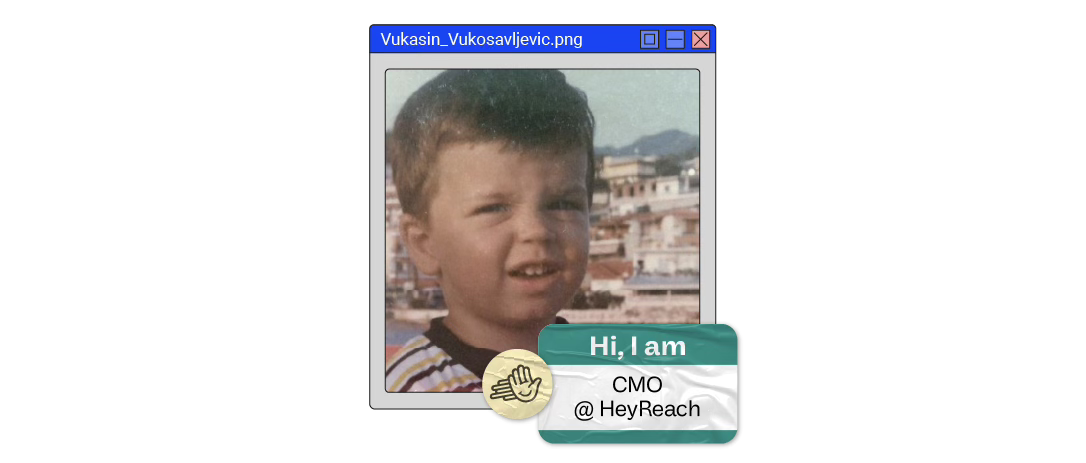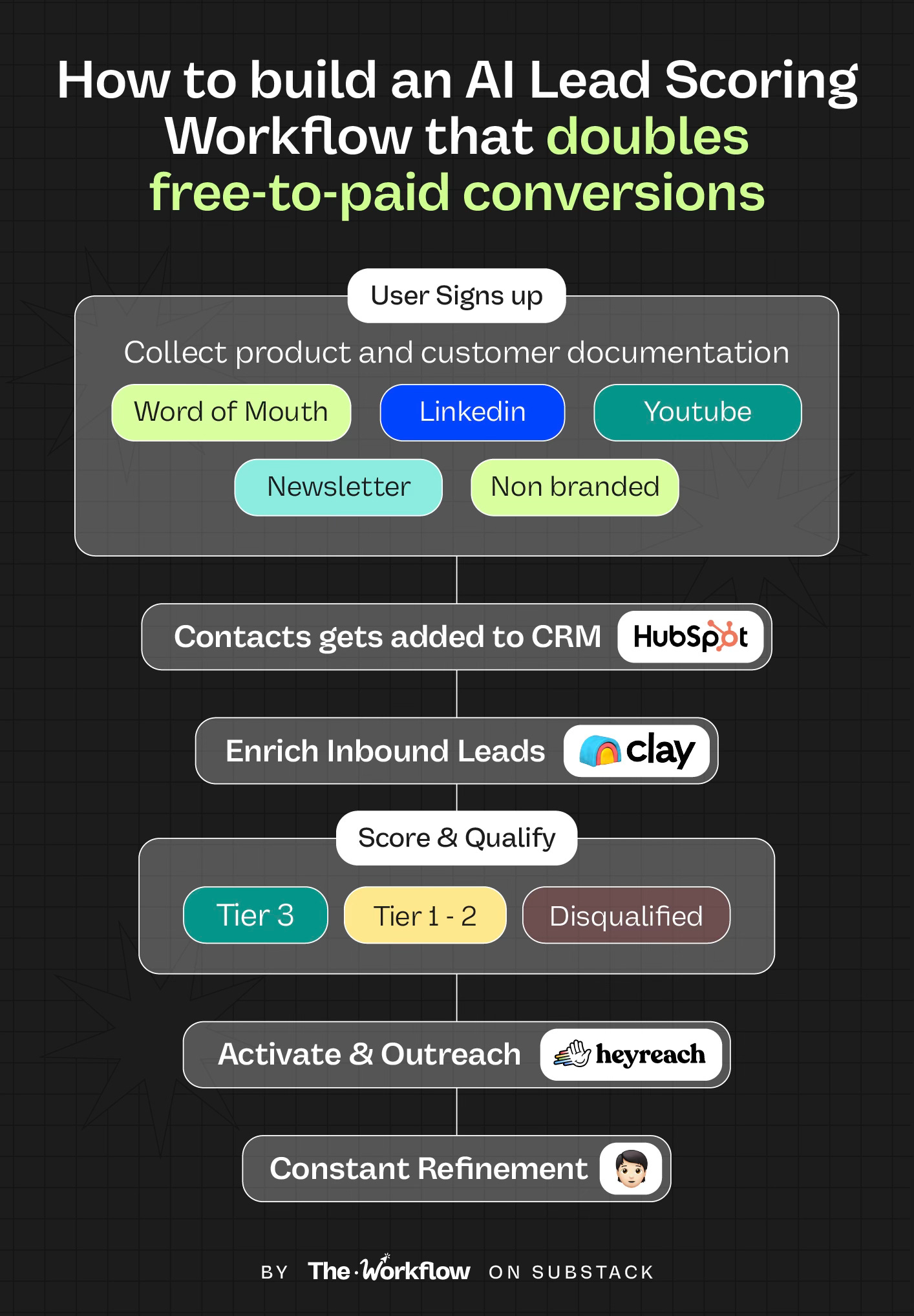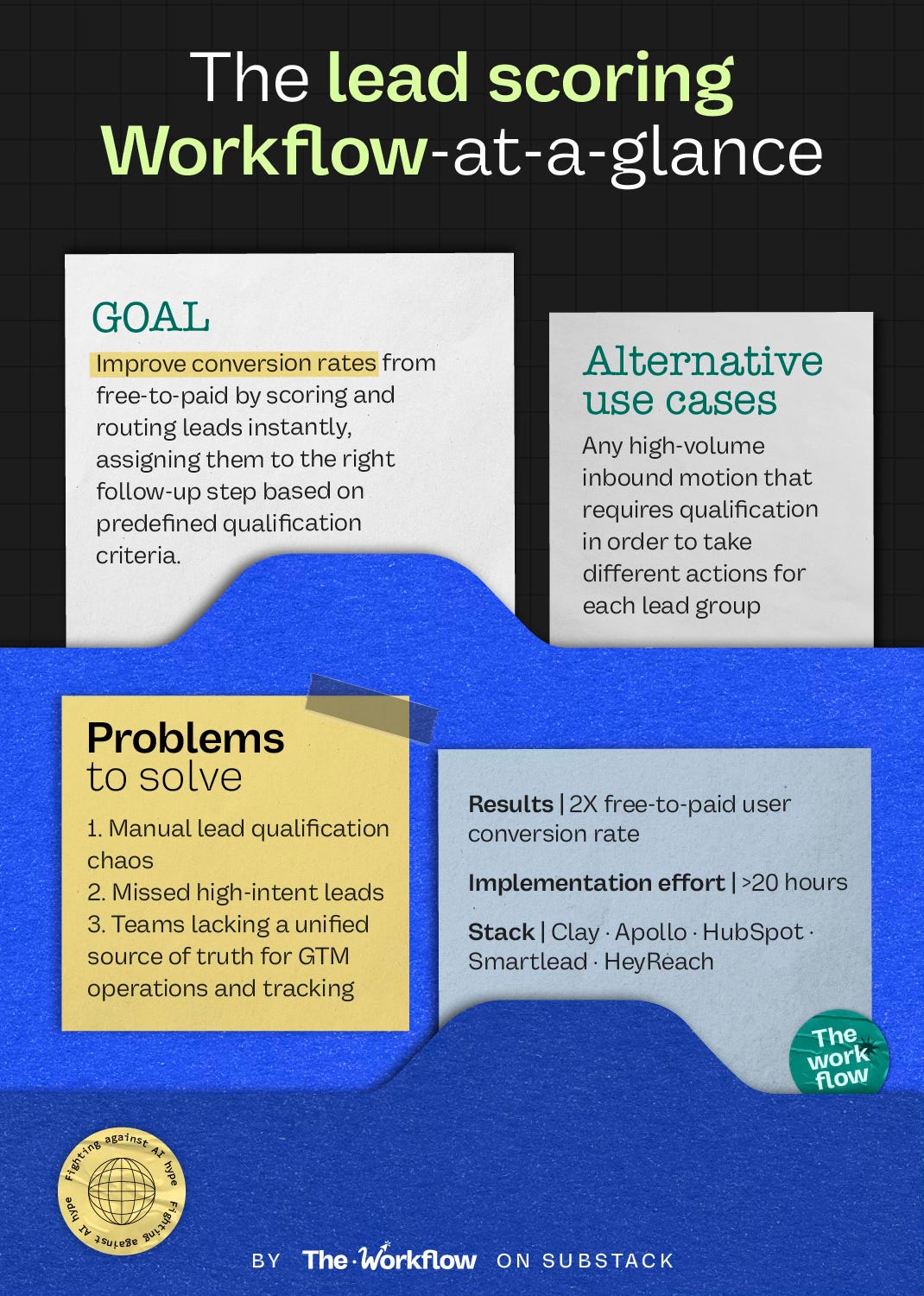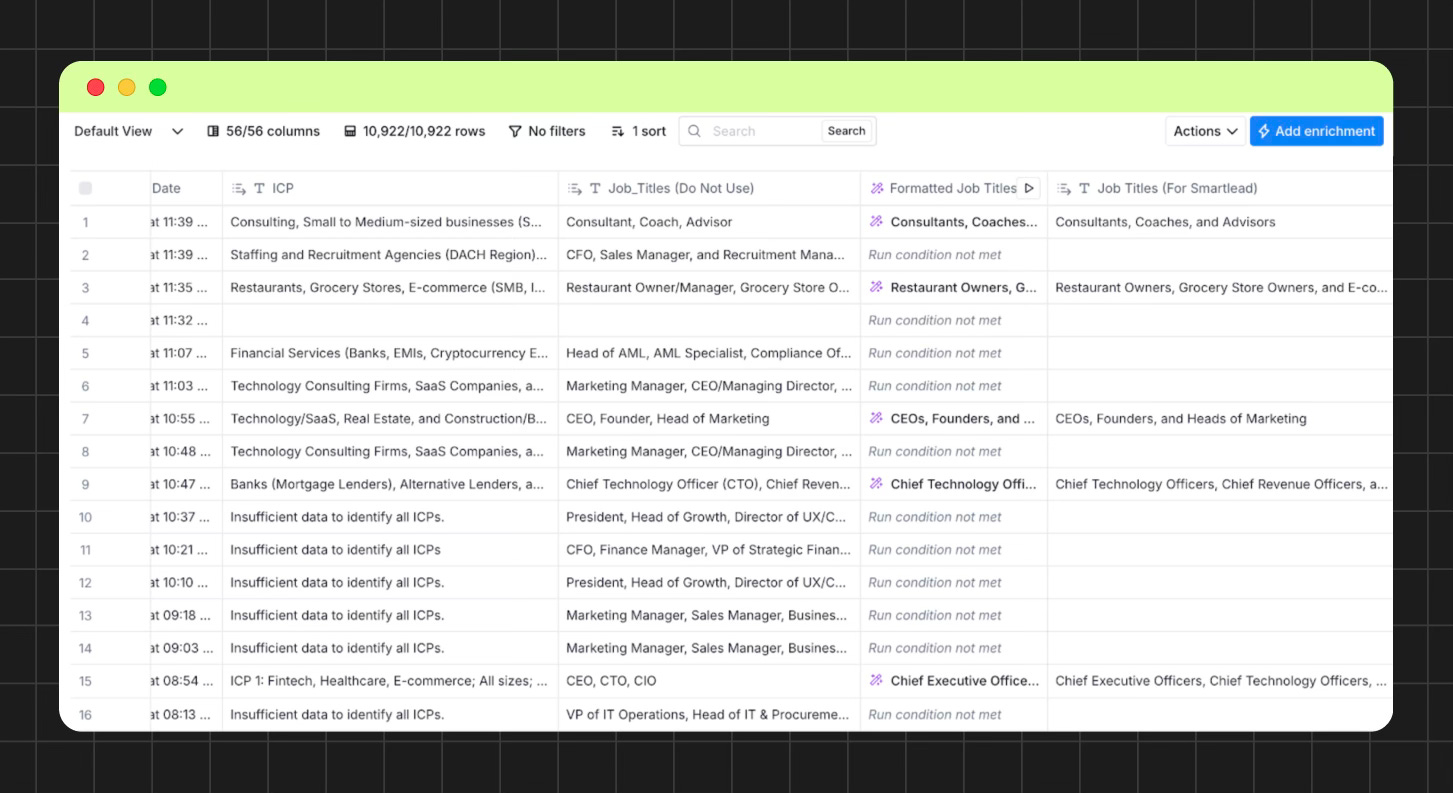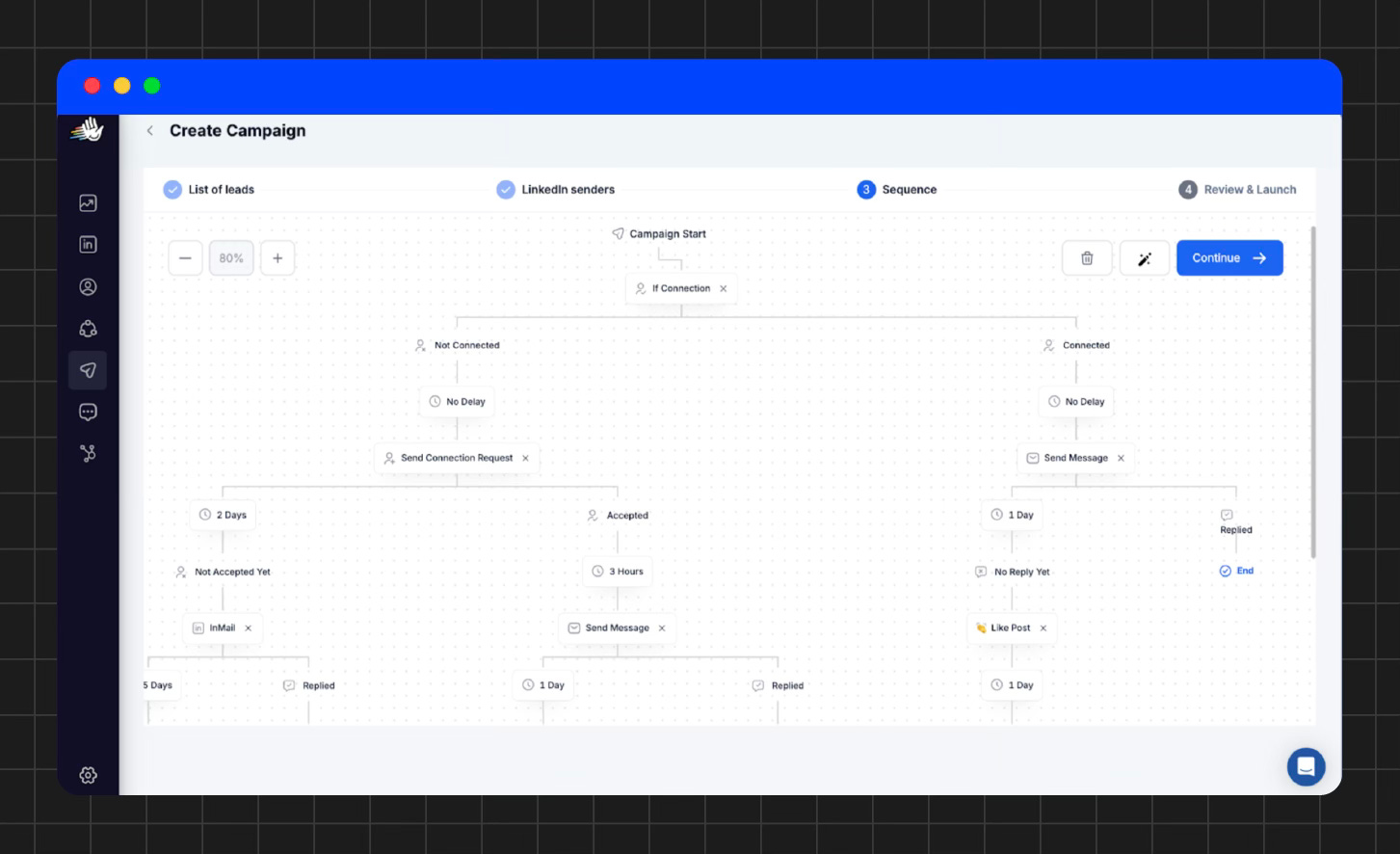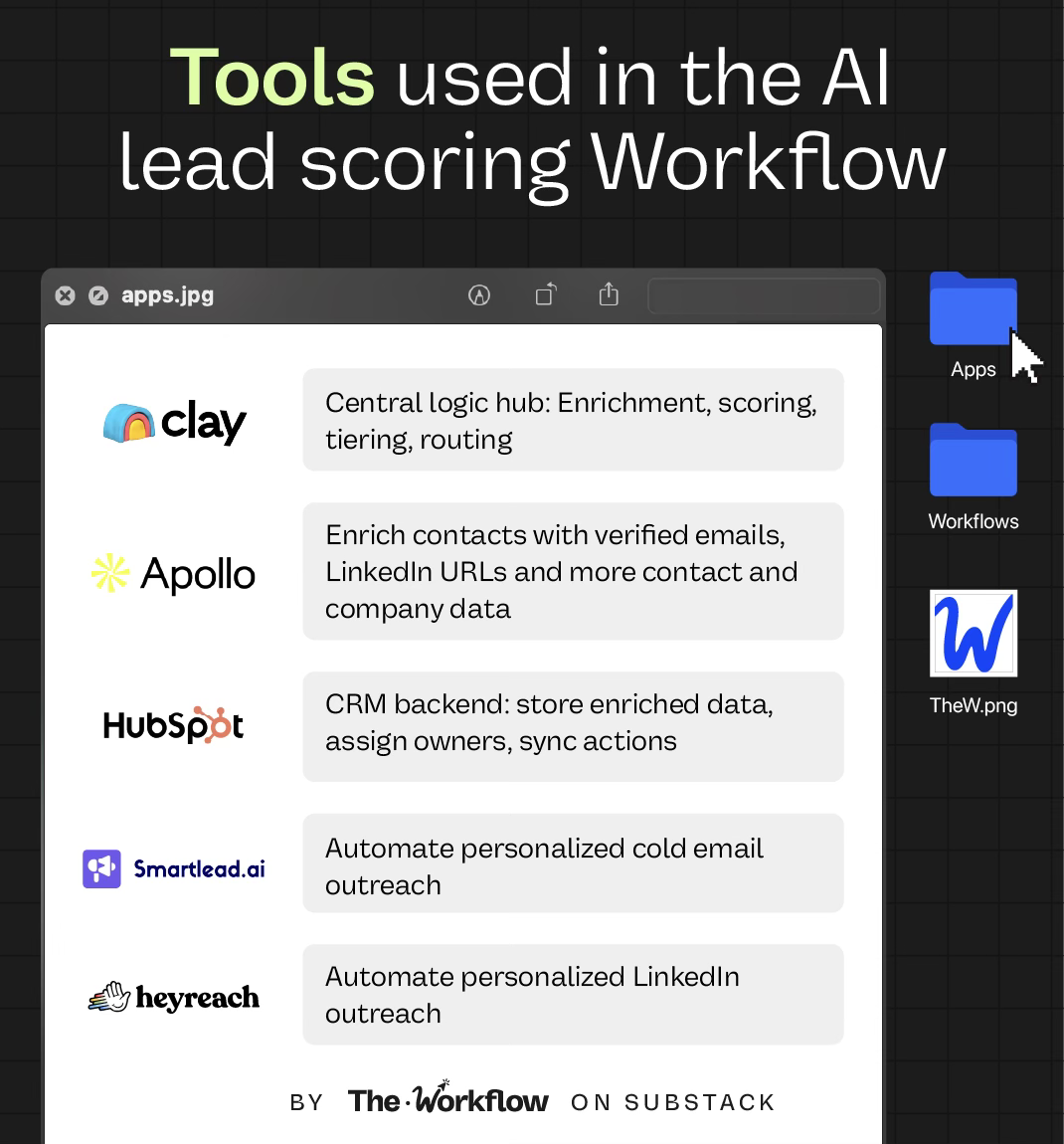The AI lead scoring Workflow to 2x free-to-paid conversions
Automatically score, qualify, and route inbound leads with this AI-powered lead scoring system for B2B SaaS teams.
Hello again from The Workflow, your brand new bi-weekly source of AI and automation playbooks for people who use tech to get real work done, not just post FOMO screenshots on LinkedIn.
This week’s issue is special: after our launch edition, it’s our first-ever guest feature, and we'd never start with just anyone. We sat down with Vukasin Vukosavljevic, CMO at HeyReach, a Balkan SaaS that hit $8M ARR in just 26 months (and a good friend of ours), to break down how to build an AI-powered lead scoring system that can run your entire go-to-market (GTM) engine.
✅ What you’ll learn
How to score leads automatically using data enrichment and Clay tables
How to route leads to CS, Sales, or Marketing instantly
The stack powering The Workflow that doubled free-to-paid conversions
How to build a system that evolves with your business
🧨 What triggered the Workflow
Lead scoring is one of those things every GTM team knows they should systematize. But most don’t. Why? Because building an automated, scalable lead scoring engine that’s accurate, flexible, and doesn’t collapse under the weight of conflicting opinions on what makes a qualified lead has always felt like a pipe dream.
Until now. At HeyReach, a LinkedIn outreach platform pulling in 2K+ free trial signups per month, Vuk and his team couldn’t afford to waste time chasing the wrong leads, or even worse, missing out on the right ones.
So they created a custom-built, automated lead scoring system that qualifies inbound leads using AI and routes them across sales, growth, marketing, and CS teams. It blends human logic, agentic AI, outbound campaigns, and a good ol’ human touch, exactly where it makes a difference.
Want to replicate this workflow or tweak it for your own use case? Keep reading.
🛠️ How to build the Workflow step-by-step
This lead scoring system has become the operational brain of HeyReach’s GTM machine. It’s smart, scalable, and something you should seriously consider, especially if you’re juggling high inbound volume from multiple sources like LinkedIn, YouTube, email, organic traffic, and referrals (key acquisition channels for HeyReach).
The impact: Conversion from free trial to paid jumped from 9% to 17%+. Salespeople now spend their time following up only with highly qualified leads. Marketing is crushing acquisition targets…and finally getting those high-fives from Sales. Lovely.
This exact workflow isn’t plug-and-play, but the logic is. Here's how it works.
1. Align on your ICP (and how to best serve them)
“We shouldn’t care about how many signups we get. We should care about how many qualified signups we get.” That insight was the real trigger for the workflow. Vuk and HeyReach’s CRO, Ilija Stojkovski, were frustrated by two things: a lack of clarity on which free trial sign-ups were actually ideal customers, and a relatively low conversion rate at the time (~9%) from trial to paid.
“I wanted to know: Are our acquisition channels bringing in the right people? Are we spending time where it counts?” Vuk asked himself.
The first step is to align internally on customer tiers and their importance to the business. Without that, any system or tool will only cause even more problems.
“You can’t score leads if you don’t know what a good one looks like.” Vuk and the team mapped their ideal customer profile into tiers:
🤝🏻 Tier 1–2: High-fit, routed to CS or Sales for human onboarding
📩 Tier 3: Medium-fit, pushed to Marketing and self-serve flows
🚫 Disqualified: Not the right audience (e.g., ecomm agencies using non-LinkedIn channels)
Only now it’s the time to get nerdy with tools.
2. Enrich inbound leads using AI agents
At HeyReach, enrichment begins the second someone starts a free trial. The team collects only a business email at signup; no friction, no long forms. From there, automation takes over.
🧲 Step 1: Trigger
A new contact is added to HubSpot (their CRM). That’s the only input the system needs to get started.
🧠 Step 2: Enrichment
Clay orchestrates a full enrichment sequence:
Apollo fetches company and contact info
The system pulls website and LinkedIn data to understand the lead’s business model and ICP, assessing whether it would benefit from using HeyReach.
If the trial signup is part of a team, only Admins and Power Users get enriched and contacted. All other team members are filtered out to avoid spamming the entire org (and to save enrichment credits).
Custom prompts in Clay generate clean, properly formatted job titles to use for HeyReach’s outbound email campaigns (more on that later).
All of this is handled in a single, monster Clay table (plus connected sub-tables), which acts as the central nervous system for scoring and routing leads.
And that’s just the enrichment layer. With a detailed profile built out (including ICP match, firmographics, behavior, and job titles), each lead is now ready for scoring, assignment to a responsible team member, and for a suitable next step.
3. Score and qualify leads (and act upon them!)
Up next: a maze of Clay columns (even Vuk admits some look like Chinese) handles scoring and lead routing automatically.
The system evaluates every free trial lead across multiple dimensions—company size, industry, ICP match, team composition, LinkedIn presence, and past tool usage. Each data point feeds into the logic that determines where the lead belongs and what action to take next, based on the four tiers defined in Step 1 (Tiers 1-3 and “Disqualified”).
This qualification is fully automated through several deeply connected Clay tables, each customized for Sales, CS, or Marketing. Teams focus only on the KPIs and signals that matter to them. All enriched and (dis)qualified contacts are synced back to HubSpot, which acts as a backend tracker while Clay remains the daily operational hub.
“This is the first company I’ve ever worked for that has their CRM under control. I don’t even need to log into HubSpot. The information lives in Clay anyway.”
Man, did he make us jealous with this statement.
4. Activate leads with targeted outreach
Once every lead is enriched, scored, and bucketed, it’s time to act. For Tier 1 and Tier 2 leads (the high-fit ones), the system triggers personalized follow-ups: assigning a CS owner in HubSpot and launching a multichannel outreach sequence using Smartlead for email and HeyReach for LinkedIn (so much for dogfooding!).
“It’s not just about qualification. It’s about knowing exactly what to do with each signup, without having to log into five tools to figure it out.”
Here’s a sample cold email template they use. Now you’ll see where all that ICP enrichment data they enrich inbound leads with really shines:
Hi [NAME],[CS NAME] here, your dedicated Account Manager. Think of me as Robin to your Batman. 💪
I’ve done some research and noticed your team is targeting [your lead’s ICP job titles].
If you’re up for it, I’d love to give you a personal walkthrough of [your tool] and help you build high-converting LinkedIn campaigns.
We could cover things like:
Building GTM playbooks
Sourcing leads from anywhere, capturing social signals, and enriching with any data points you need
Connecting [your tool] with your GTM stack [specific tools the lead uses]
Want me to share some LinkedIn strategies that always work?
Happy hunting, [CS NAME]
On LinkedIn, each campaign branches based on whether a contact is already connected or not:
💬 If already connected → Send a message, engage with a recent post, and follow up if needed.
📬 If not connected → Send a connection request. If they accept, follow up with a message. If not, trigger an InMail.
The HeyReach API makes this seamless: campaign senders are dynamically assigned based on the lead’s HubSpot owner (if one exists), so they get messages from a familiar face. One campaign, multiple senders, all automated.
Vuk shared some results from a recent outbound campaign following this strategy:
🧑🏻💻 LinkedIn: ~47% connection rate and ~20% reply rate
📧 Email: ~12.5% reply rate (with zero optimization for opens or clicks)
Where can we sign to get that??
5. Keep refining
This thing doesn’t just run. It evolves. What started as a single lead scoring system quickly turned into a full-blown GTM intelligence engine. The team keeps layering new workflows on top: acquisition reports, action-based ICP intelligence, campaign tailoring, and routing to human-led or self-serve onboarding. “Next up, my dream would be to have a fully automated system for personalized onboarding, tailor-made retention routing, and what I call my Mount Everest: fully automated churn prevention.”
🤖 Tools powering the Workflow
Not the leanest stack, admittedly, but the results more than make up for it.
Clay is the brain, running enrichment, scoring, and routing logic across Sales, CS, and Marketing. Apollo plugs in verified emails and company data. HubSpot acts as the CRM backbone where enriched records and ICP tags are stored. Smartlead takes over for automated cold email outreach and retargeting, while HeyReach powers LinkedIn campaigns synced directly with HubSpot owners through Clay’s tiering logic.
Together, they form a GTM engine that qualifies and activates leads without the team juggling five dashboards.
📌 Disclaimer: you’ll probably need a tech-savvy friend (Vuk works with several automation magicians) to replicate something this intricate.
🌟 The good news? You can swap in your preferred tools and still build a similar system. Vuk even rebuilt the whole thing in Make, because apparently managing all of this wasn’t enough. So, whether you’re using Clay or Make, Smartlead or Instantly, HubSpot or Pipedrive, this workflow adapts if you’re willing to go deep.
🎢 Highs, lows and Workflow warnings
Like every workflow we feature, this one has its sweet spots and its breaking points.
✅ What shines
Clarity unlocked: “You’re not blind anymore,” as Vuk puts it. The team stopped guessing and started knowing — what channels convert, which leads deserve attention, and why certain ICPs churn.
Conversion doubled: Within a quarter of launch, free-to-paid rates jumped from 9% to 17%.
One source of truth: Sales, CS, and Marketing now work from the same enriched data without tool-hopping, conflicting reports, or duplicate effort.
More bandwidth: With manual lead qualification reduced, the team spends time on GTM strategy instead of admin bottlenecks.
❌ What doesn’t
Maintenance load: Prompts, syncing across tools, and refining ICP logic demand constant iteration.
Complexity tax: Scaling the logic required collaboration across departments and plenty of “techie sparring partners.”
⚠️ Workflow warning
The system solves qualification and alignment, but it won’t erase every CMO headache. As Vuk joked, “Some days I still feel like I’m crying over product marketing.”
✨ The Goldflow
We close every interview with the same question: "What did building this workflow teach you about AI and automation on a macro level?"
Vuk didn’t hesitate. "My delegation skills are becoming crazier. Now I can delegate stuff to AI agents. I don't need to do it anymore on my own."
He’s not just talking about task automation, but REAL delegation. To agents, logic flows, and systems that just do the thing without human intervention.
And because Vuk’s the kind of person who loves solving problems that used to keep him up at night, seeing them finally melt away feels like magic. "It sounds fluffy, but it gives me that feeling of: Okay, now we can actually do the things I used to see only in movies."
Because the entire point of building systems like this is one: remove the mental load of hamster-wheel admin work and chaos.
Because yeah, you might still cry over product marketing, but at least now your workflows cry with you. And they file the right lead under "Tier 1" while doing it.
See you in two weeks,
Sara & Diandra
😱 Know someone struggling to set up a lead qualification system?
🌯 It’s a major wrap
This was the first-ever guest edition of The Workflow, a bi-weekly newsletter by Sara Lattanzio & Diandra Escobar, featuring one real workflow that moved the needle for someone even smarter than the system they built.
If you missed the first edition (where Sara built a full AI-powered editorial engine while yelling “AI isn’t the strategy” from the rooftops), go catch up. It might include traces of desk research that doesn’t melt your brain, outreach that doesn’t suck, and transcripts that file themselves.



